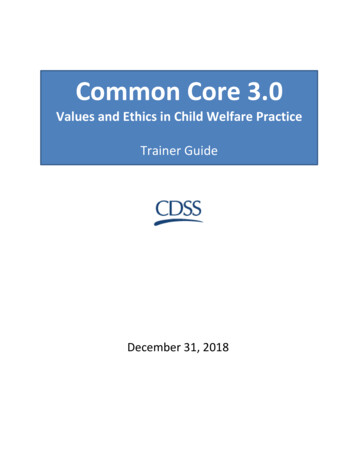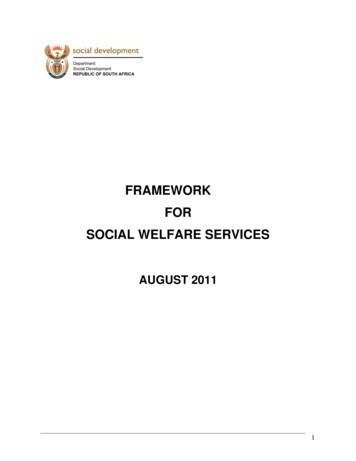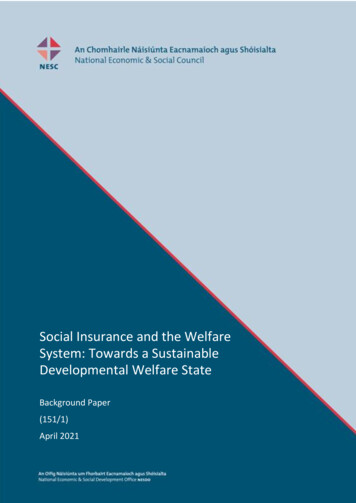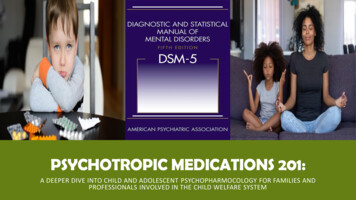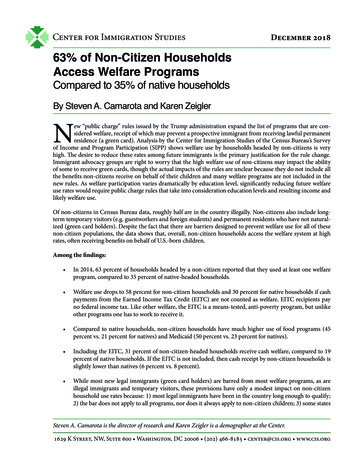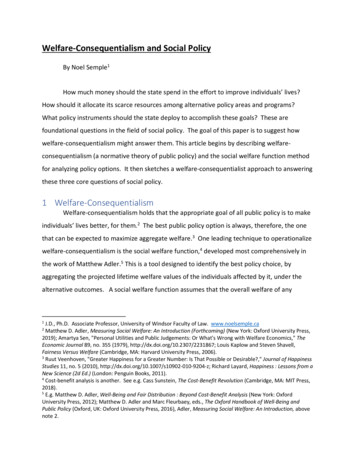
Transcription
Welfare-Consequentialism and Social PolicyBy Noel Semple1How much money should the state spend in the effort to improve individuals’ lives?How should it allocate its scarce resources among alternative policy areas and programs?What policy instruments should the state deploy to accomplish these goals? These arefoundational questions in the field of social policy. The goal of this paper is to suggest howwelfare-consequentialism might answer them. This article begins by describing welfareconsequentialism (a normative theory of public policy) and the social welfare function methodfor analyzing policy options. It then sketches a welfare-consequentialist approach to answeringthese three core questions of social policy.1 Welfare-ConsequentialismWelfare-consequentialism holds that the appropriate goal of all public policy is to makeindividuals’ lives better, for them.2 The best public policy option is always, therefore, the onethat can be expected to maximize aggregate welfare.3 One leading technique to operationalizewelfare-consequentialism is the social welfare function,4 developed most comprehensively inthe work of Matthew Adler.5 This is a tool designed to identify the best policy choice, byaggregating the projected lifetime welfare values of the individuals affected by it, under thealternative outcomes. A social welfare function assumes that the overall welfare of any1J.D., Ph.D. Associate Professor, University of Windsor Faculty of Law. www.noelsemple.caMatthew D. Adler, Measuring Social Welfare: An Introduction (Forthcoming) (New York: Oxford University Press,2019); Amartya Sen, "Personal Utilities and Public Judgements: Or What's Wrong with Welfare Economics," TheEconomic Journal 89, no. 355 (1979), http://dx.doi.org/10.2307/2231867; Louis Kaplow and Steven Shavell,Fairness Versus Welfare (Cambridge, MA: Harvard University Press, 2006).3Ruut Veenhoven, "Greater Happiness for a Greater Number: Is That Possible or Desirable?," Journal of HappinessStudies 11, no. 5 (2010), http://dx.doi.org/10.1007/s10902-010-9204-z; Richard Layard, Happiness : Lessons from aNew Science (2d Ed.) (London: Penguin Books, 2011).4Cost-benefit analysis is another. See e.g. Cass Sunstein, The Cost-Benefit Revolution (Cambridge, MA: MIT Press,2018).5E.g. Matthew D. Adler, Well-Being and Fair Distribution : Beyond Cost-Benefit Analysis (New York: OxfordUniversity Press, 2012); Matthew D. Adler and Marc Fleurbaey, eds., The Oxford Handbook of Well-Being andPublic Policy (Oxford, UK: Oxford University Press, 2016), Adler, Measuring Social Welfare: An Introduction, abovenote 2.2
2individual’s life can be represented by a single number, which can be compared to numbersrepresenting the overall welfare of other lives.6For example, suppose Frances, George, and Harriet survive a shipwreck and land on anuninhabited desert island. There is no prospect of rescue, but there is plenty of food and freshwater and the climate is mild. They therefore anticipate living on the island together for manyyears. These three survivors decide to create a welfare-consequentialist government, thedecisions of which will bind them all. Their first decision is where to build their camp: on thebeach, or on a nearby plateau. They agree that their decision on this question must bind all ofthem, because of the great advantages of living in proximity to each other.However, Frances, George, and Harriet each have different preferences and sensitivitiesthat are relevant to the question of where to live. The lifetime welfare of each will therefore beaffected in a different way by the decision about where to live. Frances enjoys the sounds ofthe waves on the beach and finds the plateau too windy. George and Harriet consider thebeach sand irritating, and they love the view from the plateau. They create two tables,comparing their aggregate welfare under the two alternative outcomes:6John Broome, "Quantities of Lifetime Wellbeing," in Weighing Lives (Oxford, UK: Oxford, 2004).
3Figure 1: Deciding Where to Make CampIf they make camp on the beach:Individual will have expectedlifetime welfare ofFrances8George3Harriet2Aggregation13(Sum):If they make camp on the plateau:Individual will have expectedlifetime welfare ofFrances3George4Harriet4Aggregation11(Sum):The premise of a social welfare function is that lifetime welfare numbers are cardinaland comparable, both between people and between outcomes.7 In other words, it can be saidthat, if the beach camp is chosen, Frances will have a better life than George, who will have abetter life than Harriet. George and Harriet would have better lives under the plateau-camppolicy than they would if the beach-camp policy is adopted.The numbers in Figure 1 represent expected lifetime welfare. This allows the socialwelfare function to accommodate uncertainty.8 Harriet’s lifetime welfare if the beach camp ischosen cannot be precisely predicted. It might depend, for example on factors such as whetherthere will be sand-flies there in the spring. If Harriet’s lifetime welfare in the beach-camp7Interpersonal welfare comparisons, although once controversial, are increasingly accepted within botheconomics and philosophy: Robert E. Goodin, Utilitarianism as a Public Philosophy (Cambridge, UK: CambridgeUniversity Press, 1995), Richard Layard and Gus O’Donnell, "How to Make Policy When Happiness Is the Goal(World Happiness Report, 2015)," accessed June 9, 2019. 5 Sep15.pdf.8For a more sophisticated treatment of uncertainty, see Adler, Measuring Social Welfare: An Introduction, abovenote 2 at Chapter 3, Section D.
4outcome would be 3 if there are no sand-flies, and 1 in there are sand-flies, and botheventualities are equally likely, then her expected welfare under this outcome is 2.9Utilitarianism is the oldest form of welfare-consequentialism. It holds that the moralvalue of an outcome is determined by simply adding up the numbers for the individualsaffected. If operating on utilitarian welfare-consequentialism, the government would decide tocreate camp on the beach. An alternative is the prioritarian social welfare function. This givesweight to equality as well as the maximization of welfare. Different prioritarian functionsreflect different degrees of aversion to inequality.10 Some prioritarian social welfare functionswould tell the castaways’ government to choose the second option (making camp on theplateau), because welfare is more evenly divided even though its sum is smaller.Regardless of whether the function is utilitarian or prioritarian, it is not the votes orchoices of the residents that make one policy option morally preferable to the other. Instead, itis the fact that aggregate welfare, under the chosen function, is higher under one than it isunder the other. Unlike self-interested voting, the social welfare function takes into accounthow large a difference a policy choice would make to each individual affected by it.1.1 Applications and Core CommitmentsThe social welfare function, or the closely related cost-benefit analysis approach, isoften applied to evaluate economic policies involving taxation and risk regulation.11 Forexample, banning a potentially dangerous chemical is considered a good policy if the positiveeffects of doing so on individuals’ welfare (e.g. better health and longer lives) can be expectedto exceed the negative effects on individuals’ welfare (e.g. lost jobs for those who manufacturethe chemical, and the removal of a market option for its consumers).129(0.5 x 3) (0.5 x 1) 2Adler, above note 8.11Sunstein, supra note 4, N. Gregory Mankiw, Matthew Weinzierl, and Danny Yagan, "Optimal Taxation in Theoryand Practice," The Journal of Economic Perspectives 23 (2009); Adler, Measuring Social Welfare: An Introduction,above note 2.12Matthew D. Adler and Nicolas Treich, "Prioritarianism and Climate Change," Environ Resource Econ 62 ; Matthew D. Adler, "A Better Calculus for Regulators: From CostBenefit Analysis to the Social Welfare Function (Working Paper Ee 17-01 March 2017)," 10
5However, the approach can, in principle, be applied to any public policy question. Aproposed residential apartment building would be allowed in a low-density area, despiteneighbourhood opposition, if the welfare benefits of the development to prospective residents,local merchants, and other affected parties would outweigh the welfare losses to theneighbours and any other affected parties.13 A military intervention to depose a foreigndictator would be justified if the aggregate expected benefits to the dictator’s potential victims,and expected security benefits for individuals elsewhere, would outweigh welfare costs such asthe loss of life in combat and financial cost of the intervention.In cases such as military intervention, some welfare effects are experienced by a policymaker’s domestic constituents while others are experienced by foreigners. The policy-makermust decide whether and how to weigh welfare effects on foreigners within the social welfarefunction. Similar value judgments must be made regarding welfare effects on unbornindividuals, and on non-human animals.14As these examples illustrate, welfare-consequentialist policy analysis almost alwaysinvolves weighing some individuals’ welfare gains against other individuals’ welfare losses.15The approach is consequentialist insofar as it evaluates public policies with exclusive referenceto the difference those policies can be expected to make in the world.16 For a welfarist policymaker, “sins of omission” (failure to put in place policies which are very likely to produce strongnet welfare benefits) are just as serious as “sins of commission”.17 Scholars in this school havedeveloped sophisticated treatments of uncertainty,18 and of policy choices which change the13More precisely, the permitted height and shape of the building would be chosen to maximize overall welfaregains from the project.14John Broome, "The Well-Being of Future Generations," in The Oxford Handbook of Well-Being and Public Policy,ed. Matthew D. Adler and Marc Fleurbaey (Oxford, UK: Oxford University Press, 2016); Olof Johansson-Stenman,"Animal Welfare and Social Decisions: Is It Time to Take Bentham Seriously?," Ecological Economics 145 8.019.15Pareto-optimal policy moves, that can make someone better off without making anyone worse off in any way,are very seldom possible for a government.16Martha C. Nussbaum, Creating Capabilities (Cambridge, MA: Harvard University Press, 2013), location 993[Kindle Edition].17Peter Singer, Ethics in the Real World: 82 Brief Essays on Things That Matter (Princeton, NJ: Princeton UniversityPress, 2016).18John C. Harsanyi, "Cardinal Welfare, Individualistic Ethics, and Interpersonal Comparisons of Utility," Journal ofPolitical Economy 63 (1955), Adler, “A Better Calculus for Regulators.”
6number of individuals who will live in the future.19 Normative individualism is another premiseof welfare-consequentialism. Individuals, not communities or other aggregations, are theentities whose welfare should matter to policy-makers.20 This is not, of course, to deny thatsocial groups have powerful instrumentally effects in making individuals’ lives better or worse.1.2 Defining and Measuring Individual WelfareWelfare-consequentialists can take different approaches to defining and measuringindividual welfare. Briefly, objective good accounts emphasize verifiable facts aboutindividuals’ lives (e.g. lifespan or education) in order to compare the quality of those lives.21Preferentist accounts define the good life in terms of the extent to which the individual’spreferences are realized.22 Mental state accounts ground welfare quantifications in howindividuals feel or what they think. Mental state accounts can be hedonic (focused onindividuals’ pains and pleasures), or evaluative (relying on an individual’s evaluation of his orher own life to indicate his or her welfare).23An evaluative mental state account of welfare underlies the increasingly influential lifeevaluation surveys, and the policy recommendations that are based on them. Respondents areasked a question such as: “all things considered, how satisfied would you say you are with yourlife these days?” They are asked to respond with a number, usually ranging from 0 (completelydissatisfied or unhappy) to 10 (completely satisfied or happy). Comparing respondents’ lifeevaluation scores with their circumstances has produced robust findings about what makespeople give higher or lower numbers.2419Katarzyna de Lazari-Radek and Peter Singer, The Point of View of the Universe : Sidgwick and ContemporaryEthics (Oxford: Oxford University Press, 2014); Broome, in The Oxford Handbook of Well-Being and Public Policy,above note 14.20L. W. Sumner, Welfare, Happiness, and Ethics (New York Oxford University Press, 1996), p. 215.21Amartya Sen, Development as Freedom (New York: Oxford, 2001); Nussbaum, Creating Capabilities, above note16.22Jonathan Baron, Morality and Rational Choice (Amsterdam: Springer Netherlands, 1993); Chris Heathwood,"Desire-Fulfillment Theory," in The Routledge Handbook of Philosophy of Well-Being, ed. Guy Fletcher (New York:Routledge, 2016).23Blends of these approaches are also possible.24Ruut Veenhoven, "Correlates of Happiness (World Database of Happiness)," accessed June 9, 2019.http://worlddatabaseofhappiness.eur.nl/hap cor/cor fp.htm.
7The increasingly widespread use of life-evaluation surveys has supported welfareconsequentialist policy-making. It has been suggested that maximizing the aggregate scoresthat people give to their lives on life-evaluation surveys should be the primary goal ofgovernment. 25 Life-evaluation scores, as a universal yardstick of policy success, are attractiveto many because the surveys empower each respondent to make his or her own decision abouthis or her welfare.26 The state then has the technical task of designing policies to maximizewelfare as defined in this way, on the basis of the best available evidence. The successfulargument for expanded public spending on mental health therapies in the UK, described below,exemplifies what might be called “life-evaluationist welfare-consequentialism.”However, life-evaluation surveys do have shortcomings, in terms of their ability to sumup an individual’s welfare. A person evaluating her own life on a scale of 0-10 cannotincorporate, in that score, things she doesn’t know about. Some such things would certainlyseem to be relevant to her lifetime welfare. Longevity is the prime example – a personevaluating her own life does not know how long she will live and her life-evaluation cannotreflect the extent to which her preferences about longevity will be fulfilled by her actual life.27It follows that a purely life-evaluationist welfare-consequentialism would give no weight to theeffect of policy options on longevity. Life-evaluation scores also cannot detect welfare on nonhuman animals, whose interests must arguably be considered in some way by welfareconsequentialist policy-makers. For these among other reasons, the author has suggested thatpreferentist measures of welfare, based on the extent to which individuals’ welfare-relevantpreferences are fulfilled, should be used to fill in the gaps left by life-evaluationism.2825Veenhoven, “Greater happiness for a Greater Number,” above note 3; Layard, above note 3; Andrew Clark et al.,The Origins of Happiness: The Science of Well-Being over the Life Course (Princeton, New Jersey: PrincetonUniversity Press, 2018) at 325.26Ed Diener et al., Well-Being for Public Policy (New York: Oxford University Press, 2009) at 47; Clark et al., abovenote 25 at 4.27Ruut Veenhoven, "Apparent Quality-of-Life in Nations: How Long and Happy People Live," Social IndicatorsResearch 71 (2005), http://dx.doi.org/10.1007/s11205-004-8014-2 at 69.28Noel Semple, "Good Enough for Government Work? Life-Evaluation and Public Policy (Working Paper, May 312019)," accessed June 9, 2019. http://ssrn.com/abstract 3397151.
82 Welfare-Consequentialism and Social PolicyIn many wealthy countries, the most politically controversial issues concern theappropriate role of the state in creating welfare. At the outset, this article identified threecore, and hotly contested questions in social policy debates: (i) how much money should thestate spend in the effort to improve individuals’ lives; (ii) how should it allocate its scarceresources among alternative policy areas and programs; and (iii) what policy instrumentsshould the state deploy to accomplish these goals. This Part considers how welfareconsequentialism might answer these three questions.2.1 Optimizing Welfare State SizeState spending on social welfare includes budget allocations from all levels ofgovernment. Functionally, state spending also includes compelled state-compelled transfers.Examples include obligatory payments between private parties (e.g. mandatory employeebenefits paid by employers), and compulsory retirement saving.Welfare-consequentialism holds that the level of spending should be chosen so as tomaximize expected aggregate welfare. Each dollar the state spends increases someone’swelfare. It will generally increase welfare for the recipient of that dollar, and it will very oftenincrease welfare for other people as well (e.g. the children of the recipient, and those fromwhom the recipient purchases things). Some state spending might constitute a trueinvestment, in the sense that it will repay itself with future revenue increases.29However each dollar of spending also has a welfare cost. The welfare cost is borne bythe taxpayer or other individual who must give it the dollar so that the state or someone elsecan spend it.30 If the state borrows the money, doing so has a welfare cost for those who willfund the eventual repayment of the debt.29Derek Curtis Bok, The Politics of Happiness What Government Can Learn from the New Research on Well-Being(Princeton: Princeton University Press, l il.action?docID 483530. at 95.30Clark et al., above note 25 at 201
9The welfare costs and benefits that can be expected if the state raises and spends thenext (marginal) dollar are the focus.31 Consider a minimalist “night watchman” state that leviesno tax and spends nothing on social policy. Raising and spending the first dollar will almostcertainly do more good than harm. This first dollar could be raised from a very small tax leviedonly on billionaires, whose welfare loss from it would be infinitesimally small. The first dollarwould be spent, under welfare-consequentialism, on the program where it would make thelargest welfare difference; perhaps a low-cost public health intervention (e.g. clean drinkingwater supply) that would make many lives much better by preventing disease.As social spending increases, the welfare benefits created by each additional dollardecrease, assuming that the most welfare-enhancing programs are always prioritized.Meanwhile, the negative welfare effects of the public financing can also be expected toincrease, after the burden passes a certain point, because the public financing eventually sapsnon-state sources of welfare. The state, obviously, is not the only source of welfare. Eachindividual pursues the things that he or she thinks will make his or her life better. People alsocontribute to others’ welfare, both altruistically (e.g. charity and family relationships), andthrough voluntary market transactions. 32 The state is only one of “four realms of provisioning,”the others being market, commons, and household.33 Beyond a certain point, the more privateresources the state conscripts in its pursuit of welfare, the less remains for non-state welfareincreasing activity. The declining marginal utility of income means that, as the governmenttakes away more and more of people’s income in tax, each additional dollar of tax becomesmore welfare-diminishing.34 Moreover, once tax rates go beyond a certain level, they diminish31“Since economists think on the margin, the welfare-economic question is typically not whether the action is rightor wrong but what is the right amount—what are the right amounts of chocolate and global warming?” (Edward R.Morey, "What Are the Ethics of Welfare Economics? And, Are Welfare Economists Utilitarians?," InternationalReview of Economics 65, no. 2 (2018), m Smith, An Inquiry into the Nature and Causes of the Wealth of Nations (London: W. Strahan and T. Cadell,1776); Milton Friedman and Rose Friedman, Free to Choose: A Personal Statement (Wilmington, MA: MarinerBooks, 1980) at 37; John Hall and John F. Helliwell, Happiness and Human Development (New York: United NationsDevelopment Programme, 2014) at 12.33Kate Raworth, Doughnut Economics : Seven Ways to Think Like a 21st Century Economist (2017), at 136.34Richard Layard, "Happiness and Public Policy: A Challenge to the Profession," The Economic Journal 116, no. 510(2006), http://dx.doi.org/10.1111/j.1468-0297.2006.01073.x "
10the incentive to earn and thereby suppress economic activity which broadly undermineswelfare.The level of spending at which costs begin to exceed benefits is, of course, one of themost contentious issues dividing left and right. Welfare-consequentialism offers an objective,rational answer to the question of whether any given state should increase or decrease itssocial spending. It should choose the level of spending which has the largest net welfarebenefits.2.2 Prioritization of Spending AreasA second major question of social policy pertains to the allocation of scarce resourcesamong alternative projects to enhance welfare. Money is obviously a scarce resource forstates, but so are time and political capital. Welfare-consequentialism holds that stateresources should be allocated in the manner most likely to maximize aggregate welfare.35In practice, this means (i) producing more of the life situations that are empiricallydemonstrated to increase individual welfare, and (ii) suppressing the life situations thatdemonstrably suppress it. The magnitude of the welfare correlations (in terms of effects onindividual welfare) and their amenability to policy intervention are both relevant.36 Wheneveraggregate expected long-run welfare can be increased by reallocating funds from program areaX to program area Y, the government should do so.2.2.1 The Argument for Mental Health SpendingThe welfare-consequentialist approach is illustrated by the recent, successful push forshifting UK spending from physical health programs toward mental health programs. Thisargument, advanced by economist Richard Layard and his collaborators, exemplifies welfareconsequentialist policy analysis grounded in life-evaluation measures of individual welfare. 3735As an example of this reasoning, a recent report from the UK’s All-Party Parliamentary Group on WellbeingEconomics argued that “the Treasury should ask departments to justify their bids in terms of their impact onwellbeing.” All-Party Parliamentary Group on Wellbeing Economics (UK), A Spending Review to Increase Wellbeing:An Open Letter to the Chancellor (London, UK: What Works Centre for Wellbeing, ng-APPG2019.pdf36Diener et al., above note 26 at 134.37Richard Layard and David M. Clark, Thrive: The Power of Psychological Therapy (London, UK: Penguin, 2013).
11Within this argument, life-evaluation data is used first to establish the importance of thiswelfare-decreasing phenomenon, and then to establish the efficiency of the proposed solution(state-funded therapies) as a way to increase aggregate welfare, relative to other things thegovernment might spend money on instead. In particular, the efficiency of mental healthspending is compared favourably to that of physical health programs in this body of work.Mental health problems are more common than many people believe. They affectroughly 20% of the population of OECD countries in any given year.38 Mental health status isamong the best predictors of an individual’s life-evaluation in many wealthy countries. Forexample, according to a large-scale study of Connecticut residents, a reported life-evaluationimprovement of 25.2 points out of 100 can be expected when an individual moves from “veryoften” feeling “down, depressed or hopeless in the past month” to “never” feeling that way.39In the UK, mental health has substantially greater effect on life evaluation than income,employment status, or physical health.40The samples in life-evaluation studies are large and diverse enough to allow causationrelationships to be established. It is not the case, according to this research, that povertyand/or unemployment are the real root causes of low life-evaluations, and these phenomenaalso cause mental health problems. Rather, mental health problems – which afflict employedand wealthy people almost as often as they afflict unemployed and poor people – are theleading root cause of low life-evaluation.41 The large samples also mean that sources of bias inlife-evaluation responses (e.g. the tendency of respondents to give different numbers ondifferent days of the week) do not prevent causation relationships from being identified.People adapt to some things over time, causing the effects of those things on lifeevaluation to fade. For example, life-evaluation suffers a sharp drop after bereavement, but it38OECD, Making Mental Health Count: The Social and Economic Costs of Neglecting Mental Health Care (Paris:OECD, 2014), ental-health-count-9789264208445-en.htmat 16.39Christopher Barrington-Leigh and Jan T. Wollenberg, "Informing Policy Priorities Using Inference from LifeSatisfaction Responses in a Large Community Survey," Applied Research in Quality of Life .40Clark et al., above note 25 at 214.41Ibid. at 325.
12recovers over time.42 This is not the case for mental health conditions: one does not get usedto them. They typically make one’s life-evaluation substantially worse for as long as they last.43Establishing the long-term welfare-suppressing effects of mental health problems is notsufficient to establish a welfare-consequentialist case for increased mental health spending.Some things that make people’s lives worse for them (e.g. rainy weather or heartbreak) mightbe beyond the capacity of any government to prevent or mitigate. Mental health problems arenot in this category. Interventions such as cognitive behavioural therapy have been proven toimprove individuals’ mental health, and thus their life-evaluations, according to Layard & Clark.Moreover, many people who would benefit from such treatments will not obtain them unlessthe government helps them do so.Improving the life-evaluations of those with mental health problems is the most directwelfare benefit of publicly-funded mental health services. Call this a “first order” welfarebenefit. However, the depth and breadth of life-evaluation research allows it to identifyrelatively small welfare effects, and effects brought about by complex chains of causation.“Second-order” or “knock-on” welfare benefits occur when a “mediating” factor or individualcauses the intervention to have an additional effect, on someone else. 44 In this case, treatingthe mental health problems of parents eventually improves the life-evaluation scores of theirchildren, by allowing the service-recipients to be more effective parents. Treating working-ageadults is also likely to improve economic productivity and tax revenues, by improving theemployment prospects of those receiving treatment. 45Thus, the welfare benefits of improving mental health services include first-orderbenefits for service-recipients, and second-order benefits for those who rely on servicerecipients at home or work. Physical health problems, by contrast, are more likely to afflictolder people without jobs or young children. This is one reason why a welfare-consequentialist42Ibid. at 179Layard, “Happiness and Public Policy,” above note 34 at 29.44Nicholas Stern, Stern Review: The Economics of Climate Change (London, UK: Government of the UnitedKingdom, 2006),http://mudancasclimaticas.cptec.inpe.br/ rmclima/pdfs/destaques/sternreview report complete.pdf at 27.45Layard and Clark, at 44; All-Party Parliamentary Group on Wellbeing Economics (UK), at 11.43
13reallocation of total public health spending between mental and physical health services wouldfavour the former category.46Apparently accepting Layard et al.’s argument, the UK government substantiallyincreased publicly-funded mental health services. The Improving Access to PsychologicalTherapies (IAPT) program, created in 2008, provided services to over 1 million people per yearby 2019.47 IAPT’s contribution (if any) to the significant recent improvements in UK aggregatelife-evaluation scores has not been identified.48 However, it would be reasonable for thisprogram, and its intellectual progenitors, to take some credit.Building on this success, Layard and his collaborators applied this approach to a broadrange of public policy options in their 2018 monograph Origins of Happiness.49 In a chapter onbudgeting, they describe alternative techniques to ensure that spending priorities are chosenrationally on welfare-consequentialist grounds. They call on governments to "rank all possiblepolicies in terms of the extra happiness which they generate per dollar of expenditure, startingwith the most effective and working down.”50Rationally dividing a fixed health budget between mental an
the chemical, and the removal of a market option for its consumers).12 9 (0.5 x 3) (0.5 x 1) 2 10 Adler, above note 8. 11 Sunstein, supra note 4, N. Gregory Mankiw, Matthew Weinzierl, and Danny Yagan, "Optimal Taxation in Theory and Practice," The Journal of Economic Perspectives 23 (2009); Adler, Measuring Social Welfare: An Introduction,


